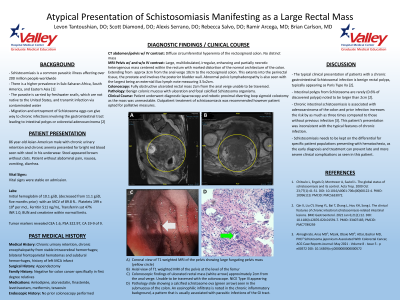Back


Poster Session A - Sunday Afternoon
Category: Colon
A0147 - Atypical Presentation of Chronic Schistosomiasis as a Large Obstructing Rectal Mass
Sunday, October 23, 2022
5:00 PM – 7:00 PM ET
Location: Crown Ballroom

Has Audio

Levon Tantoushian, DO
Valley Hospital Medical Center
Las Vegas, NV
Presenting Author(s)
Levon Tantoushian, DO1, Scott Diamond, DO1, Alexis Serrano, DO2, Rebecca Salvo, DO1, Brian Carlson, MD1
1Valley Hospital Medical Center, Las Vegas, NV; 2Valley Medical Hospital Center, Las Vegas, NV
Introduction: Schistosomiasis is a common parasitic illness affecting over 200 million people worldwide with a higher prevalence in Sub-Saharan Africa, South America, and Eastern Asia [1]. The parasite is carried by freshwater snails, which are not native to the United States, and transmit infection via contaminated water. Acute intestinal infection with schistosomiasis can lead to intestinal mucosal hyperemia, edema, and ulceration with clinical manifestations of fevers, diarrhea, and abdominal pain [2,3]. Migration and entrapment of Schistosoma eggs can give way to chronic infections involving the gastrointestinal tract leading to intestinal polyps or colorectal adenocarcinoma [3].
Case Description/Methods: We present a case of chronic intestinal Schistosomiasis in an 86-year-old Asian-American male, who presented to the hospital with a low volume, slow rate, lower gastrointestinal bleed. CT abdomen and pelvis with contrast revealed diffuse circumferential hyperemia of the rectosigmoid colon without distinct masses. Colonoscopy revealed a near-complete obstructing ulcerated rectal mass, 2cm from the anal verge, which was unable to be safely traversed with the colonoscope. A pelvic MRI with contrast showed a large multilobulated heterogeneous mass centered within the rectum extending into the perirectal tissues and prostate measuring 8.2 x 0.5 x 10 cm. Rectal mass biopsies revealed benign colonic mucosa with ulceration and focal calcified Schistosoma organisms, without the presence of dysplasia or carcinoma. This patient subsequently elected for a proximal diverting loop sigmoid colostomy with palliative intent.
Discussion: The typical clinical presentation of patients with a chronic gastrointestinal Schistosomal infection is benign rectal polyps, typically appearing as Paris Type IIa [3]. Our literature review revealed no previously documented intestinal polyps to be larger than 2cm. Chronic intestinal schistosomiasis is also associated with adenocarcinoma of the colon and prior infection increases the risk by as much as three times compared to those without previous infection [5]. This patient’s presentation was inconsistent with the typical features of chronic infection. Schistosomiasis needs to be kept on the differential for specific patient populations presenting with hematochezia as the early diagnosis and treatment can prevent late and more severe clinical complications as seen in this patient.
Disclosures:
Levon Tantoushian, DO1, Scott Diamond, DO1, Alexis Serrano, DO2, Rebecca Salvo, DO1, Brian Carlson, MD1. A0147 - Atypical Presentation of Chronic Schistosomiasis as a Large Obstructing Rectal Mass, ACG 2022 Annual Scientific Meeting Abstracts. Charlotte, NC: American College of Gastroenterology.
1Valley Hospital Medical Center, Las Vegas, NV; 2Valley Medical Hospital Center, Las Vegas, NV
Introduction: Schistosomiasis is a common parasitic illness affecting over 200 million people worldwide with a higher prevalence in Sub-Saharan Africa, South America, and Eastern Asia [1]. The parasite is carried by freshwater snails, which are not native to the United States, and transmit infection via contaminated water. Acute intestinal infection with schistosomiasis can lead to intestinal mucosal hyperemia, edema, and ulceration with clinical manifestations of fevers, diarrhea, and abdominal pain [2,3]. Migration and entrapment of Schistosoma eggs can give way to chronic infections involving the gastrointestinal tract leading to intestinal polyps or colorectal adenocarcinoma [3].
Case Description/Methods: We present a case of chronic intestinal Schistosomiasis in an 86-year-old Asian-American male, who presented to the hospital with a low volume, slow rate, lower gastrointestinal bleed. CT abdomen and pelvis with contrast revealed diffuse circumferential hyperemia of the rectosigmoid colon without distinct masses. Colonoscopy revealed a near-complete obstructing ulcerated rectal mass, 2cm from the anal verge, which was unable to be safely traversed with the colonoscope. A pelvic MRI with contrast showed a large multilobulated heterogeneous mass centered within the rectum extending into the perirectal tissues and prostate measuring 8.2 x 0.5 x 10 cm. Rectal mass biopsies revealed benign colonic mucosa with ulceration and focal calcified Schistosoma organisms, without the presence of dysplasia or carcinoma. This patient subsequently elected for a proximal diverting loop sigmoid colostomy with palliative intent.
Discussion: The typical clinical presentation of patients with a chronic gastrointestinal Schistosomal infection is benign rectal polyps, typically appearing as Paris Type IIa [3]. Our literature review revealed no previously documented intestinal polyps to be larger than 2cm. Chronic intestinal schistosomiasis is also associated with adenocarcinoma of the colon and prior infection increases the risk by as much as three times compared to those without previous infection [5]. This patient’s presentation was inconsistent with the typical features of chronic infection. Schistosomiasis needs to be kept on the differential for specific patient populations presenting with hematochezia as the early diagnosis and treatment can prevent late and more severe clinical complications as seen in this patient.
Disclosures:
Levon Tantoushian indicated no relevant financial relationships.
Scott Diamond indicated no relevant financial relationships.
Alexis Serrano indicated no relevant financial relationships.
Rebecca Salvo indicated no relevant financial relationships.
Brian Carlson indicated no relevant financial relationships.
Levon Tantoushian, DO1, Scott Diamond, DO1, Alexis Serrano, DO2, Rebecca Salvo, DO1, Brian Carlson, MD1. A0147 - Atypical Presentation of Chronic Schistosomiasis as a Large Obstructing Rectal Mass, ACG 2022 Annual Scientific Meeting Abstracts. Charlotte, NC: American College of Gastroenterology.
